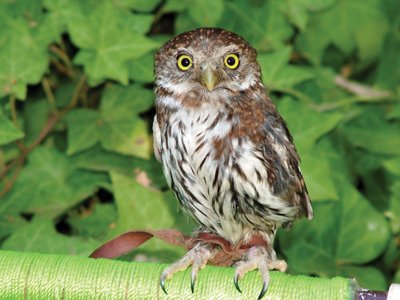In November 2009, a northern pygmy owl (glaucidium californicum
or gnoma) was brought to Cascades Raptor Center in Eugene, Ore.,
for rehabilitation. It possibly suffered a collision with a vehicle
or window since x-rays showed that the left shoulder had multiple
fractures.
In November 2009, a northern pygmy owl (glaucidium californicum or gnoma) was brought to Cascades Raptor Center in Eugene, Ore., for rehabilitation. It possibly suffered a collision with a vehicle or window since x-rays showed that the left shoulder had multiple fractures. The wing was bandaged, and after it had healed, the owl was placed in a small aviary to recuperate. However, it still could not fly well and was only able to flutter short distances.
Sadly, his injury was permanent and he could not be released back to his woodland habitat.
Perfect flight is important to pygmy owls since they are diurnal (active during daytime) and must compete with other day-hunting predators for the rodents, birds, reptiles and amphibians that make up their diet.
Unlike nocturnal (night-hunting) owls such as barn owls, screech owls and great horned owls, pygmy owls are visual hunters. They lack the silent flight feathers, prominent facial feather disc and asymmetrical ear structure of the nocturnal owls that hunt mainly by listening for prey.
While the little owl is perching and searching for its meals, it must avoid being attacked by songbirds. As a defense, the pygmy owl has distinctive markings on the back of its head that mimic an owl’s eyes and beak.
To a bird flying overhead, it would look like the owl is staring right up at it. And that bird has good reason to fear a pygmy owl, which measure only 6 inches long – the tiny owl is a ferocious hunter and can kill a bird as big as a quail or dove – twice its size.
This pygmy owl’s story has a happy ending. He was transferred to the Wildlife Education and Rehabilitation Center in July 2010, given the name “Wally” and has joined WERC as its newest educational animal ambassador and a member of the newly-formed O.W.L. team, comprised of Oscar the western screech owl, Wally the pygmy owl and Luna the great horned owl.
The O.W.L. team will be an important part of WERC’s Silent Hunters classroom program, where schoolchildren will learn about the habitats and behaviors of these raptors.












